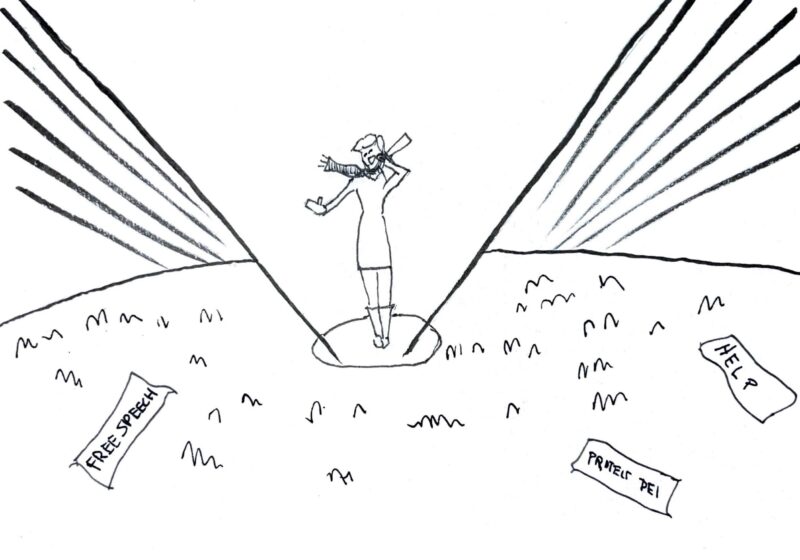After nearly two years of uncertainty, a lengthy proposal, and months of discussion, University President Sarah Mangelsdorf decided this past Wednesday not to return the flag display to Hirst Lounge, SA Campus Life Chair Lillian Hutton revealed to the Campus Times. A new committee will be formed in October to determine an alternative way to represent the diverse community at UR.
The proposal Mangelsdorf reviewed presented two opinions, the first, heavily favored by students, advised that the flags be immediately returned to Hirst Lounge, and that the Students’ Association Government (SA) be the only entity in charge of adding, removing, and organizing them. It also suggested reframing the display as a way to express student identities rather than nationalities, and included 10 pages of student testimonials in support of the flag lounge. The second opinion, which was supported by members of administration and faculty, was to remove the flags in Hirst Lounge indefinitely, and replace them with something else. Mangelsdorf sided with the second opinion to remove the flags.
The flags were initially removed and placed under review in August 2020 in response to numerous disputes over the flag lounge in the past years, including a controversy over the Hong Kong and Taiwan flags in November 2019 and a suggested removal of the Palestinian flag in October 2019. Following this controversy, months before the flags were removed, a Flag Advisory Committee (FAC) was formed to discuss the future of the display, composed of various staff, students, and faculty from all University schools. The FAC was tasked with creating a proposal for President Mangelsdorf, with the final decision to be made solely by her.
Due to the COVID-19 pandemic, the FAC was disrupted from March 2020 until August 2020. The Committee was not ready to meet online, and was swept up in the transition to online learning. Before the FAC could reconvene, the Hirst Lounge flags were abruptly removed. At the time of the removal, SA leadership was told that the flags were taken down for a cleaning, according to SA Campus Life Chair and senior Lillian Hutton and Marc Haddad ’21, who was SA Vice President in 2020.
“They didn’t need to fully come down [for a cleaning],” Hutton said. “And even some of our advisors who work in Wilson Commons and work directly with Student Government and handle the flags, [whose] whole responsibility is Wilson Commons, didn’t know or were [not] told this was happening.”
The decision to remove the flags was made by President Mangelsdorf and then-Provost Rob Clark, according to both Haddad and an email sent to the undergraduate student body by former SA President Justina Gorka ‘21 on Aug. 14, 2020.
During the fall 2020 semester, the FAC did not meet, FAC student members were unable to learn why the flags had come down, and SA created a subcommittee of undergraduates who met several times.
Junior subcommittee member Alexandra Fegler joined due to her family’s roots in Hong Kong. “I wanted to make sure that there were actual Taiwanese and Hong Kong student voices being heard and that that side was involved in the committee,” Fegler said. “Marc felt that it was important to have student voices because this is a student space and the administrators don’t really come through here; the flag display doesn’t really impact them at all.”
In spring 2021, during the first FAC meetings after the removal, Hutton said that students were still not told why the flags had come down.
“In those committee meetings, we tried to get an answer to who took them down and why, and we never got an answer,” Hutton said. “We were talking with very high level admins from various different offices. The [President’s Office], deans, Global Engagement — and we asked who did it, and why? And no one had a firm answer. It was a cop-out, which was frustrating because I’d rather you say, ‘You know what, we felt like it was too hard.’ It became obvious throughout the year that a couple people very high up just felt like it was too challenging. They believed the display caused more harm than good.”
“Although they didn’t say it explicitly, the obvious issue is that the University doesn’t want to get involved in geopolitical issues,” Haddad said.
The FAC included members from every major school at UR, such as the Medical Center, the Warner School of Education, and University Communications and Strategy. Haddad, who became co-chair of the committee in spring 2021, recalled that it was difficult to get everyone on the committee to attend every meeting.
“Because those meetings happened virtually, sometimes one week, some person would show up and then another representative from the group would show up,” Haddad said. “There were some consistent students and consistent members of the administrators there all the time, and those would be the five or six people that very, very consistently worked on this.”
One topic that repeatedly came up was if the flags were a good way to represent the many identities in the University community. According to Jim Ver Steeg, Vice President of the Office for Equity and Inclusion and committee member, some questioned whether the flags were the best method of student representation.
“Perhaps one of the biggest challenges was an opinion held by some that the flags represented diversity and inclusion,” Ver Steeg wrote in an email to the Campus Times. “The flags that were on display in Hirst Lounge represented nationalism and internationalism, and that is an important distinction. We had a couple conversations about how geopolitical identities [such as] borders [and] nationalities […] are not always appropriate determinants for how we think about equity, diversity, and inclusion. Those two ideas became linked in the minds of some of the committee members, but issues of diversity and inclusion are often very different from issues of internationalism.”
Laura Ballou, Director of Wilson Common Student Activities, described an open dialogue of ideas between students and faculty. “I really appreciated that there were faculty voices on the committee to be able to have those conversations,” she said. “I was really impressed by all the students that were members of the committee. You could see their passion. They did a lot of really good work in the undergraduate subcommittee to be able to bring forward students’ voices and ideas.”
Saab praised how the committee was able to represent diverse perspectives. “I feel like the exchange of ideas and opinions is crucial, and I feel like this committee was good because, as I said, people are coming from different points of view and have different stakes,” she said. “I do feel like everybody on the committee listens to one another, and respects one another’s views.”
At the end of April, the committee drafted their proposal for what should happen to the flag lounge. But according to Hutton, the first draft — written by Vice Provost for Global Engagement Jane Gatewood and a representative from the Communications department — stated that the committee’s consensus was that the flags should be removed from Hirst Lounge, which failed to capture the student perspectives of the FAC.
While student representatives agreed the flags didn’t fully capture a person’s identity, they still believed the display was important to the University community, and that the flags should not be removed indefinitely. The first proposal only included the conclusion to remove the flags, the belief most administrators and faculty FAC members held, with the exception of a few.
“We have our last meeting and we’re supposed to have this proposal done and we get the draft ahead of time and we’re reading through it. And I’m like, how is this the opposite — not even just not close to it, it’s the opposite — of what we were saying. [The proposal] essentially was like, ‘We [unanimously] agree the flag should come down.’”
At the end of June 2021, Haddad and Hutton rewrote the proposal to also include the student’s conclusion on the flags and 10 pages of student testimony, which Saab approved and sent directly to President Mangelsdorf for her to review.
While the committee was split on their decision on what should happen to the flags, the Committee unanimously agreed that President Mangelsdorf should apologize to the University community for the consistent lack of communication and transparency regarding the removal of the display. The committee thought that the community should have been informed officially about the removal of the flags.
Before President Mangelsdorf disclosed her decision to members of the committee, Saab described her thoughts on the final proposal.
“I mean, here’s the thing: I hope that we just don’t keep having more and more committees,” Saab said. “I hope that we come to some sort of movement. But maybe we do. I mean, we are a university and we have to. We have a ton of different people that are part of the University community, and I think we want to be respectful and inclusive and as much as we can. And so I think because of that, there are people who want quick answers and quick responses. But I think sometimes you have to think through and be very deliberate to make sure that nobody feels left out or offended. And that’s hard because I personally am one of those people who is like, I want a response yesterday, but it’s a big institution, and I think that she’s giving it a lot of thought and I’m hopeful.”
This past Wednesday, President Mangelsdorf met with Hutton, Saab, and Associate Dean of Students and Director of Student Activities Anne-Marie Algier about her final decision on the flag lounge. President Mangelsdorf decided that the flags should not return to Hirst Lounge, due to the controversy raised over them in recent years. (Editor’s note: Click here to see CT coverage of those controversies.)
Hutton does not believe that this means the flags are gone for good. Hutton mentioned there is a strong push from alumni, especially recent graduates, to return the flags. Hutton believes that there needs to be more input from the student community over the flag lounge, whether or not it’s a difficult conversation to have.
“Unfortunately, I made the point that about 95 percent of the students here and even the ones who had an issue with the flag didn’t want them down,” Hutton said. “But the President believes that there’s still too many issues with it, and that’s unfortunate. Because it felt like it was just taking the easy [route] to take them down, rather than having the tough conversations about why there are issues. The campus community was never polled about the flags, which was one of the roles of the committee, but due to a variety of reasons that never happened. We need to gather input.”
Hutton wants the conversations to continue with the new committee, but also with the student body and SA. Hutton pointed to the fact that students still ask about the flags, both on campus and online, with many unsure of what happened to them in the first place. She encouraged students to continue talking about the display and share what it meant to them.
“We need people to share their stories,” Hutton explained. “[10 pages of student testimonies] was great and warranted, but apparently that wasn’t enough for them. […] I remember the flags when I toured, and different cultural groups with flags. We need to let them know we still want them back up. I think that we’ll put enough pressure on the administration to realize that it’s actually something that’s very special to Rochester.” Hutton quoted Laura Ballou’s description of Hirst Lounge as the living room of UR. “It’s not unique, we’re not the only ones with flags up, but it’s [something] that for the last 25 going on 30 years has been in the living room of our campus.”



